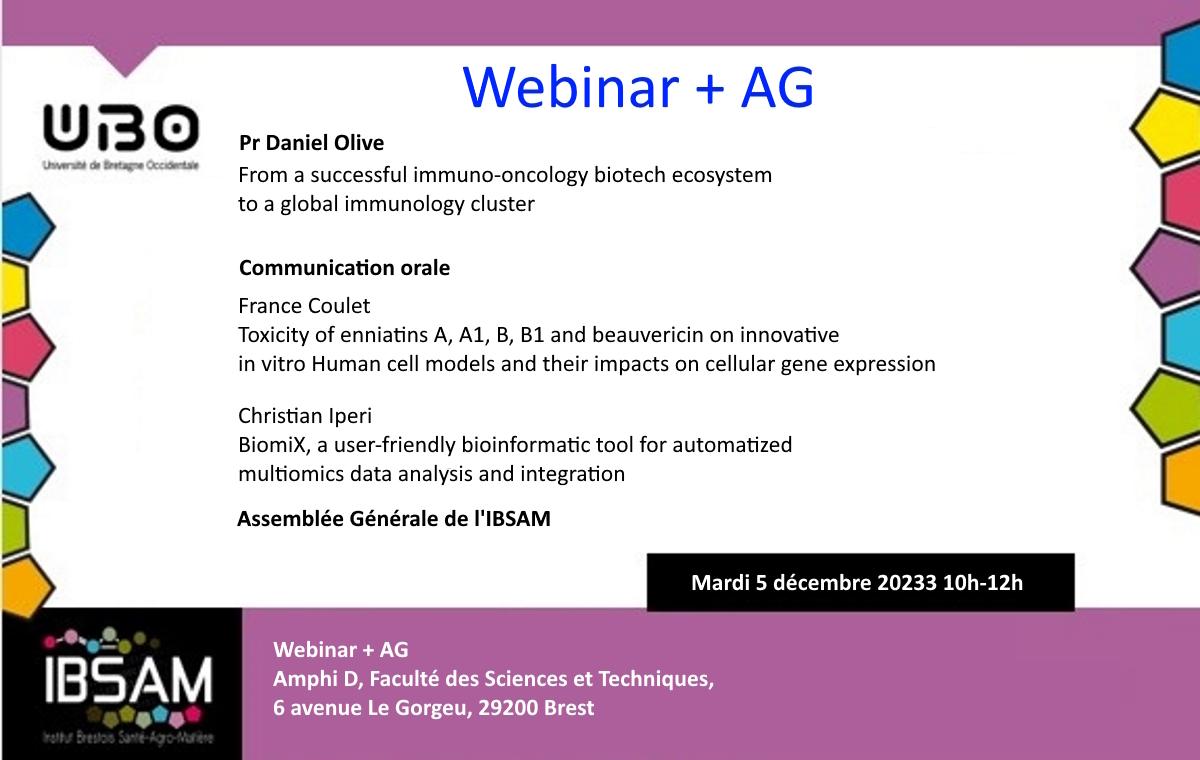
BiomiX, a user-friendly bioinformatic tool for automatized multiomics data analysis and integration.
Cristian Iperi 1 , Álvaro Fernández-Ochoa 2, , Jacques-Olivier Pers 1 , Guillermo Barturen 3,4 , Marta Alarcón-Riquelme 3,5, PRECISESADS Flow Cytometry Study Group, PRECISESADS Clinical Consortium, PRECISESADS Metabolomics Study Group, Divi Cornec 1 , Anne Bordon 1* , Christophe Jamin 1,6*
1 LBAI, UMR1227, Univ Brest, Inserm, Brest, France, 2 Department of Analytical Chemistry, University of Granada, Granada, Spain, 3 GENYO, Centre for Genomics and Oncological Research Pfizer, University of Granada, Andalusian Regional Government, PTS Granada, Granada, Spain, 4 Department of Genetics, Faculty of Sciences, University of Granada, Granada, Spain, 5 Institute for Environmental Medicine, Karolinska Institutet, Stockholm, 171 69, Sweden 6 Laboratoire d’Immunologie et Immunothérapie, CHU de Brest, Brest, France, 29609 Brest, * The two last authors contributed equally to this work.
Objective. Usage of high-throughput technology in health and biological sciences boosted the amount of information obtainable from samples. The increased dependency on these technologies revealed how data analysis represent the bottleneck step in both time and in bioinformatics skilled users. BiomiX tool offers an efficient and time saving pipeline to analyze -omics data singularly and integrate multiomics data from the same patients.
Methods. BiomiX was developed from the European PRECISESADS database1, including overlapping data of whole blood and sorted immune cells, transcriptomics, plasma and urine metabolomics, and whole blood methylomics from 363 SLE patients and 508 controls (CTRLs). Transcriptomics data were analysed through a differential gene expression (DGE) analysis using Deseq package, while plasma and urine metabolomics peaks changes were quantified and statistically tested. Peaks annotation was performed automatically by comparing m/z, retention time and spectra stored in public databases. Methylomics analysis was performed by ChAMP R package. Common sources of variations among the -omics was identified by Multi-Omics Factor Analysis (MOFA) integration.
Results. Biomix carried out analyses highlighting the most relevant features for each -omics, including statistical results and report figures. To facilitate interpretation, files ready for pathway analysis tools as EnrichR, GSEA and MetaboAnalyst are generated. A panel of genes can be also used by BiomiX to define a subgroups of patients, and compare them to CTRLs (e.g SLE IFN-α positive patients by 26 IFN-α genes). To ease the MOFA factors interpretation, BiomiX automatically select the MOFA factors statistically relevant in discriminate condition and control, providing the correlation of each factor with clinical features and articles where the top contributors to the factor appear simultaneously in the text (e.g genes, peak, cpg_island).
Conclusions. This user-friendly tool, based on R is compatible for Linux and Microsoft OS, and aim to make accessible the multiomics analysis to users not expert in bioinformatics.
Références.
1- Barturen, G. et al. Integrative Analysis Reveals a Molecular Stratification of Systemic Autoimmune Diseases. Arthritis Rheumatol. Hoboken NJ 73, 1073–1085 (2021).
Toxicity of enniatins A, A1, B, B1 and beauvericin on innovative in vitro Human cell models and their impacts on cellular gene expression.
France Couleta, Monika Cotona, Cristian Iperib, Marine Berlinger-Poidevina, Emmanuel Cotona, Nolwenn Hymerya
a- Univ. Brest, INRAE, Laboratoire Universitaire de Biodiversité et Écologie Microbienne, F-29280 Plouzané, France
b- Univ. Brest, Univ Brest, Inserm, Lymphocytes B, Autoimmunité et Immunothérapies UMR 51227, F-29200 Brest, France
Mycotoxins contaminate more than 70% of cereal crops worldwide and therefore constitute a public health problem [1]. Fusarium spp. are the most frequent in cereal crops and produce both regulated (T-2 toxin, deoxynivalenol, zearalenone) and emerging (enniatins, beauvericin) mycotoxins [2]. A few in vitro studies, mainly on ENNs B and B1, have shown various effects including DNA alteration, apoptosis, mitochondrial damage and production of reactive oxygen species. Yet, the lack of in vitro and in vivo ENN toxicity data prevents robust human health risk assessment [3]–[5]. We investigated the in vitro cytotoxic effects of these mycotoxins on HepaRG cells in 2D and 3D models in differentiated and undifferentiated states. After acute exposure, cytotoxic effects showed that emerging mycotoxins had similar inhibitory concentrations to regulated mycotoxins. To understand the impact of ENN B1 and ENN B exposure on gene expression of HepaRG spheroids, transcriptomic study was carried out and pinpointed differentially expressed genes and similar pathways were involved in cell responses. Complement cascades, steroid hormones, bile secretion and cholesterol pathways were all negatively impacted. For cholesterol biosynthesis, 23/27 genes were significantly down-regulated and could be correlated to a 30% reduction in cholesterol levels. Our results showed for the first time the impact of ENNs on the cholesterol biosynthesis pathway. This finding suggests a potential negative effect on human health due to the essential role this pathway plays.
Références.
[1] G. Schatzmayr et E. Streit, « Global occurrence of mycotoxins in the food and feed chain: facts and figures », World Mycotoxin J., vol. 6, no 3, p. 213‑222, août 2013, doi: 10.3920/WMJ2013.1572.
[2] D. Ferrigo, A. Raiola, et R. Causin, « Fusarium Toxins in Cereals: Occurrence, Legislation, Factors Promoting the Appearance and Their Management », Molecules, vol. 21, no 5, p. 627, mai 2016, doi: 10.3390/molecules21050627.
[3] A. Juan-García, L. Manyes, M.-J. Ruiz, et G. Font, « Involvement of enniatins-induced cytotoxicity in human HepG2 cells », Toxicol. Lett., vol. 218, no 2, p. 166‑173, avr. 2013, doi: 10.1016/j.toxlet.2013.01.014.
[4] A. Prosperini, A. Juan-García, G. Font, et M. J. Ruiz, « Reactive oxygen species involvement in apoptosis and mitochondrial damage in Caco-2 cells induced by enniatins A, A1, B and B1 », Toxicol. Lett., vol. 222, no 1, p. 36‑44, sept. 2013, doi: 10.1016/j.toxlet.2013.07.009.
[5] G. Meca, G. Font, et M. J. Ruiz, « Comparative cytotoxicity study of enniatins A, A1, A2, B, B1, B4 and J3 on Caco-2 cells, Hep-G2 and HT-29 », Food Chem. Toxicol., vol. 49, no 9, p. 2464‑2469, sept. 2011, doi: 10.1016/j.fct.2011.05.020.


